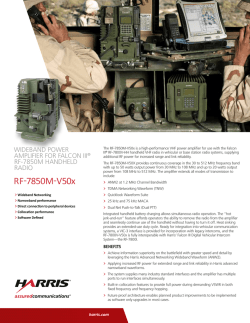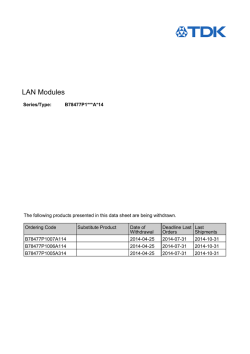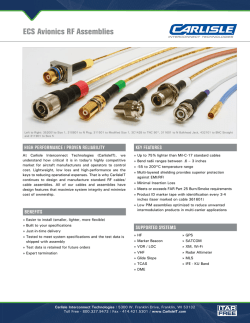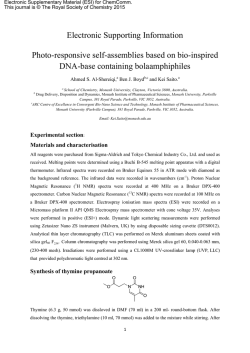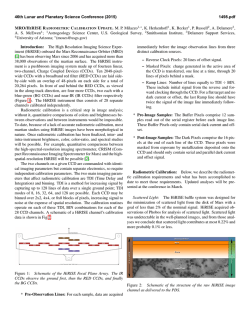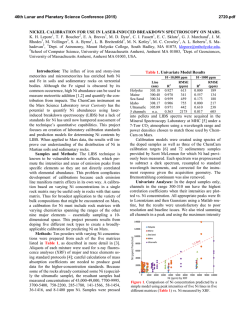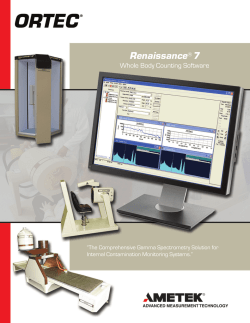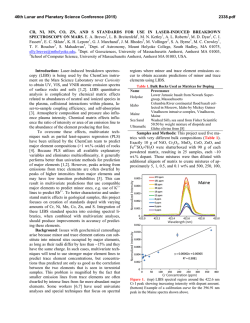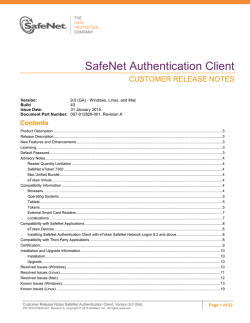
SPIRIT1 Errata sheet
SPIRIT1 Errata sheet SPIRIT1 device limitations Silicon identification This errata sheet applies to the STMicroelectronic's SPIRIT1. The full list of part numbers is shown in the table below. Table 1: Device summary Part numbers Device info (stored in register 0xF0 and 0xF1) Comment SPIRIT1QTR 0x0130 Cut 3.0 Preliminary engineering samples 0x0103 or 0x0104 Cut 2.1 January 2015 DocID023165 Rev 6 1/12 www.st.com Contents SPIRIT1 Contents 1 Limitations ....................................................................................... 4 1.1 1.2 1.3 1.4 1.5 1.6 1.7 2 1.1.1 Part number affected .......................................................................... 4 1.1.2 Description .......................................................................................... 4 1.1.3 Workaround ........................................................................................ 4 Extra current consumption after power-on ........................................................ 5 1.2.1 Part number affected .......................................................................... 5 1.2.2 Description .......................................................................................... 5 1.2.3 Workaround ........................................................................................ 5 With STack packet format, last byte missed from RX FIFO .................................... 6 1.3.1 Part number affected .......................................................................... 6 1.3.2 Description .......................................................................................... 6 1.3.3 Workaround ........................................................................................ 6 Transmission issue after a reception with auto ACK ............................................... 6 1.4.1 Part number affected .......................................................................... 6 1.4.2 Description .......................................................................................... 6 1.4.3 Workaround ........................................................................................ 6 Termination of CSMA algorithm in back off mode ................................................... 7 1.5.1 Part number affected .......................................................................... 7 1.5.2 Description .......................................................................................... 7 1.5.3 Workaround ........................................................................................ 7 Failure of TX FIFO auto-reload during the automatic retransmission .......................................................................................................... 7 1.6.1 Part number affected .......................................................................... 7 1.6.2 Description .......................................................................................... 7 1.6.3 Workaround ........................................................................................ 7 Sensitivity issue at low battery voltage .................................................................... 8 1.7.1 Part number affected .......................................................................... 8 1.7.2 Description .......................................................................................... 8 1.7.3 Workaround ........................................................................................ 8 Limitations on preliminary engineering samples.......................... 9 2.1 2/12 Automatic VCO calibration .................................................................................. 4 Bad RCO automatic calibration if the crystal frequency (fXO) is 24 MHz, 25 MHz, or 26 MHz ................................................................................ 9 2.1.1 Part number affected .......................................................................... 9 2.1.2 Description .......................................................................................... 9 2.1.3 Workaround ........................................................................................ 9 DocID023165 Rev 6 SPIRIT1 Contents 2.2 2.3 3 Receiver frequency offset if the crystal frequency (fXO) is 48 MHz, 50 MHz, or 52 MHz............................................................................................................... 10 2.2.1 Part number affected ........................................................................ 10 2.2.2 Description ........................................................................................ 10 2.2.3 Workaround ...................................................................................... 10 RX startup failure ................................................................................................... 10 2.3.1 Part number affected ........................................................................ 10 2.3.2 Description ........................................................................................ 10 2.3.3 Workaround ...................................................................................... 10 Revision history ............................................................................ 11 DocID023165 Rev 6 3/12 Limitations SPIRIT1 1 Limitations 1.1 Automatic VCO calibration 1.1.1 Part number affected SPIRIT1QTR and preliminary engineering samples. 1.1.2 Description In sporadic cases, the VCO calibrator sets an inaccurate calibration word. This can cause an error, the inability to communicate, during the carrier frequency. 1.1.3 Workaround The following workaround is to use manual calibration and store the calibration word in the micro for each center frequency that the application intends to use. This manual calibration procedure should be repeated periodically to compensate for the temperature variation. The steps are as follows: 1. 2. 3. 4. 5. 6. 7. 8. 9. 4/12 Set the T split time to the longest value (3.47 ns) to facilitate calibrator operation, write 1 in SEL_TSPLIT, register SYNTH_CONFIG[0] (register address 0x9F). It is recommended to set this register during radio initialization. If the reference clock is 48 MHz, 50 MHz or 52 MHz and the reference divider is not enabled, it must be enabled. Write 1 in the REFDIV bitfield, register SYNTH_CONFIG (register address 0x9E), and set the center frequency using the reference divider. The VCO current must be increased by writing 0x19 in the register VCO_CONFIG (register address 0xA1). Enable automatic calibration of the VCO, writing 1 in VCO_CALIBRATION, register PROTOCOL[2] (register address 0x50). This step must be carried out only when the device is used as a transmitter. a. Send a LOCKTX command and wait for the SPIRIT1 to go into LOCK state. b. Read the VCO calibration word from VCO_CALIBR_DATA, register RCO_VCO_CALIBR_OUT[0] (register address 0xE5). Write the value read into the VCO_CALIBR_TX, in register RCO_VCO_CALIBR_IN[1] (register address 0x6E); optionally this value can be saved in the micro NVM. c. Send a READY command and wait for SPIRIT1 to go into READY state. This step must be carried out only if the device is used as a receiver. a. Send a LOCKRX command and wait for the SPIRIT1 to go into LOCK state. b. Read the VCO calibration word from VCO_CALIBR_DATA, register RCO_VCO_CALIBR_OUT[0] (register address 0xE5). Write the value read into the VCO_CALIBR_RX, in register RCO_VCO_CALIBR_IN[0] (register address 0x6F); optionally this value can be saved in the micro NVM. c. Send a READY command and wait for SPIRIT1 to go into READY state. Disable the automatic calibration of the VCO, write 0 in VCO_CALIBRATION, register PROTOCOL[2] (register address 0x50). Restore the VCO current by writing 0x11 in the register VCO_CONFIG (register address 0xA1). If step 2 was executed, restore the reference divider state. Write 0 in the REFDIV bitfield, register SYNTH_CONFIG (register address 0x9E). Again, set the center frequency. DocID023165 Rev 6 SPIRIT1 Limitations It is strongly suggested to repeat this sequence if the ambient temperature changes by many degrees. 1.2 Extra current consumption after power-on 1.2.1 Part number affected SPIRIT1QTR and preliminary engineering samples. 1.2.2 Description In some samples, when a supply voltage below 2.6 V is applied to SPIRIT1 from a no power condition, an extra current is added to the typical current consumption. In the following table, the current consumption in SHUTDOWN state is reported according to the supply voltage. Table 2: Current consumption in SHUTDOWN state 1.2.3 VBAT [V] IBAT [µA] 2.4 ~150 2.2 ~110 2.0 ~74 1.8 ~22 Workaround In order to avoid this extra current, after the supply voltage below 2.6 V is provided to SPIRIT1, SPIRIT1 must exit from the SHUTDOWN state and the following operations must be done: 1. 2. 3. Write 0xCA in the register PM_TEST, register address 0xB2 Write 0x04 in the register TEST_SELECT, register address 0xA8 Write 0x00 in the register TEST_SELECT, register address 0xA8 Between steps 2 and 3, some microseconds are needed. This small delay is automatically made by the second SPI operation (considering an SPI clock of max 10 MHz). With this sequence, the extra current is erased. The workaround must be repeated only when a voltage supply below 2.6 V is applied to SPIRIT1 from a no power condition. A reset operation made by the SRES command or by driving the SDN pin to put SPIRIT1 in SHUTDOWN does not cause the issue again. DocID023165 Rev 6 5/12 Limitations SPIRIT1 1.3 With STack packet format, last byte missed from RX FIFO 1.3.1 Part number affected SPIRIT1QTR and preliminary engineering samples. 1.3.2 Description Using the STack packet format and no CRC field, the reading from RX FIFO to the last received byte, is not possible. 1.3.3 Workaround By configuring the packet handler with at least one byte of CRC, the problem is solved. If the CRC is not required in the application, configure one byte of CRC in the receiver only, to read the payload correctly from RX FIFO. 1.4 Transmission issue after a reception with auto ACK 1.4.1 Part number affected SPIRIT1QTR and preliminary engineering samples. 1.4.2 Description The problem appears when the STack packet format and the automatic acknowledgment are used. If, during a receipt operation, no packet is correctly received and therfore no ACK packet is sent, at the next transmission of the packet with an ACK request (automatic acknowledgement must be disabled in this condition), the automatic reception phase is aborted. 1.4.3 Workaround Making a dummy transmission (with PA off and the highest data rate) between the reception phase with no ACK packet transmitted and the desired transmission with ACK request. 6/12 DocID023165 Rev 6 SPIRIT1 Limitations 1.5 Termination of CSMA algorithm in back off mode 1.5.1 Part number affected SPIRIT1QTR and preliminary engineering samples. 1.5.2 Description The maximum number of reached back offs does not indicate the end of the algorithm: another transmission is tried after this event. 1.5.3 Workaround In order to correctly detect the event of the maximum number of reached back offs, the following steps are suggested: 1. 2. Set the desired maximum number of back offs and add one When the event of the maximum number of back offs occurs: a. disable the CSMA b. send the SABORT command This allows the CSMA, in back off mode, to be ended in a controlled way 1.6 Failure of TX FIFO auto-reload during the automatic retransmission 1.6.1 Part number affected SPIRIT1QTR and preliminary engineering samples. 1.6.2 Description Under the following conditions: • • • STack packet format Automatic re-transmission Maximum number of re-transmissions greater than 1 Occasionally, the third packet transmitted and the next consecutive packets have the payload shifted by two bytes. 1.6.3 Workaround The situation can be detected and the corrupted re-transmissions avoided using the following procedure. At the second RX phase waiting the ACK packet, if the ACK packet is not received correctly and the number of bytes into the TX FIFO is not 0, then the NMAX_RETX must be changed to 1 to abort the retransmission. DocID023165 Rev 6 7/12 Limitations SPIRIT1 1.7 Sensitivity issue at low battery voltage 1.7.1 Part number affected SPIRIT1QTR and preliminary engineering samples. 1.7.2 Description The RX sensitivity performance of SPIRIT1 is degraded when the VBAT goes below 1.9 V. The sensitivity degrades proportional down to 1.8V where the worst sensitivity performance is achieved. The following table shows an example of the impact of VBAT on sensitivity performances. Table 3: Impact of VBAT on sensitivity performances VBAT (mV) Sensitivity (dBm) 1800 -82 1820 -85.5 1840 -96 1860 -104 1880 -105.5 1900 -105.5 1920 -105 1940 -105.5 1960 -105 Test conditions Modulation: 2FSK, Datarate: 38.4 kbps, Frequency deviation: 20 kHz, Channel bandwidth: 100 kHz, and PER: 1 %. 1.7.3 Workaround No workaround exists for this issue and customers are recommended to use VBAT ≥ 2 V if the sensitivity degradation is not acceptable in their application. 8/12 DocID023165 Rev 6 SPIRIT1 2 Limitations on preliminary engineering samples Limitations on preliminary engineering samples The limitations listed in this section apply only to preliminary engineering samples that have been delivered in the earlier version with the development kits. 2.1 Bad RCO automatic calibration if the crystal frequency (fXO) is 24 MHz, 25 MHz, or 26 MHz 2.1.1 Part number affected Preliminary engineering samples 2.1.2 Description By default, the digital clock divider is enabled and this allows it to work with an fXO of 48 MHz, 50 MHz, or 52 MHz. But with an fXO of 24 MHz, 25 MHz, or 26 MHz, the RCO calibration word is not correct. As a result, the RCO cannot be used and SPIRIT1 cannot go into the SLEEP state. 2.1.3 Workaround The digital clock divider must be disabled in a safe way. The procedure must be executed at device startup (from SHUTDOWN to READY) and after each SRES command. The steps are as follows: 1. 2. 3. 4. 5. 6. Send an SRES command (command code 0x70) Disable the RCO automatic calibration by writing 0 in the RCO_CALIBRATION bitfield, register PROTOCOL[2] (register address 0x50). Send a STANDBY command (command code 0x63) Disable the divider of the digital part by writing 1 in the PD_CLKDIV bitfield, register XO_RCO_TEST (register address 0xB4). Enable the RCO automatic calibration by writing 1 in the RCO_CALIBRATION bitfield, register PROTOCOL[2] (register address 0x50). Send a READY command (command code 0x62) Please ensure that no additional delay is inserted between step 1 and step 2. DocID023165 Rev 6 9/12 Limitations on preliminary engineering samples SPIRIT1 2.2 Receiver frequency offset if the crystal frequency (fXO) is 48 MHz, 50 MHz, or 52 MHz 2.2.1 Part number affected Preliminary engineering samples. 2.2.2 Description When fXO is 48 MHz, 50 MHz, or 52 MHz, there is a positive offset on the frequency set that is equal to the intermediate frequency (IF) setting, the recommended value of which is 480 kHz. For this reason, the receiver is not centered at the desired frequency. A workaround to fix this situation consists of manually changing the center frequency when switching between RX and TX, and vice-versa. This means that automatic acknowledgment, automatic retransmission, and CSMA do not work if fXO is 48 MHz, 50 MHz, or 52 MHz. 2.2.3 Workaround A value equal to IF must be added to the center frequency of the receiver only. For example, if the center frequency chosen is 868.000 MHz, for the receiver only the center frequency programmed must be 868.480 MHz. It is important to notice that when SPIRIT1 is switched back to transmission mode, the desired frequency (without offset) is set. 2.3 RX startup failure 2.3.1 Part number affected Preliminary engineering samples. 2.3.2 Description In some samples, the reception operation sometimes fails to start; the local oscillator frequency is incorrectly set and the receiver is not able to receive at the desired frequency. This is more frequent in the high frequency band. 2.3.3 Workaround In order to safely start the reception operation, follow the steps below: 1. 2. 3. 4. 10/12 After an RX command (command code 0x61) Write 1 in the VCO_L_SEL or VCO_H_SEL bitfields, register SYNTH_CONFIG[1] (register address 0x9E), according to which VCO is not used. In this way both the VCO_L_SEL and VCO_H_SEL are 1. Wait about 50 µs Write 0 in VCO_L_SEL or VCO_H_SEL according to which VCO is not used DocID023165 Rev 6 SPIRIT1 3 Revision history Revision history Table 4: Document revision history Date Revision Changes 04-May-2012 1 Initial release 08-May-2012 2 Updated device information in Table 1: "Device summary" 05-Oct-2012 3 Updated device information in Table 1: "Device summary" Inserted Section 1.1: "Automatic VCO calibration" Minor text changes 06-Feb-2013 4 Added Section 1.3: "With STack packet format, last byte missed from RX FIFO", Section 1.4: "Transmission issue after a reception with auto ACK", Section 1.5: "Termination of CSMA algorithm in back off mode", Section 1.6: "Failure of TX FIFO auto-reload during the automatic retransmission". Minor text changes 21-Mar-2013 5 Added Section 1.2: "Extra current consumption after power-on" 28-Jan-2015 6 Added Section 1.7: "Sensitivity issue at low battery voltage" Minor text changes DocID023165 Rev 6 11/12 SPIRIT1 IMPORTANT NOTICE – PLEASE READ CAREFULLY STMicroelectronics NV and its subsidiaries (“ST”) reserve the right to make changes, corrections, enhancements, modifications, and improvements to ST products and/or to this document at any time without notice. Purchasers should obtain the latest relevant information on ST products before placing orders. ST products are sold pursuant to ST’s terms and conditions of sale in place at the time of order acknowledgement. Purchasers are solely responsible for the choice, selection, and use of ST products and ST assumes no liability for application assistance or the design of Purchasers’ products. No license, express or implied, to any intellectual property right is granted by ST herein. Resale of ST products with provisions different from the information set forth herein shall void any warranty granted by ST for such product. ST and the ST logo are trademarks of ST. All other product or service names are the property of their respective owners. Information in this document supersedes and replaces information previously supplied in any prior versions of this document. © 2015 STMicroelectronics – All rights reserved 12/12 DocID023165 Rev 6
© Copyright 2026

